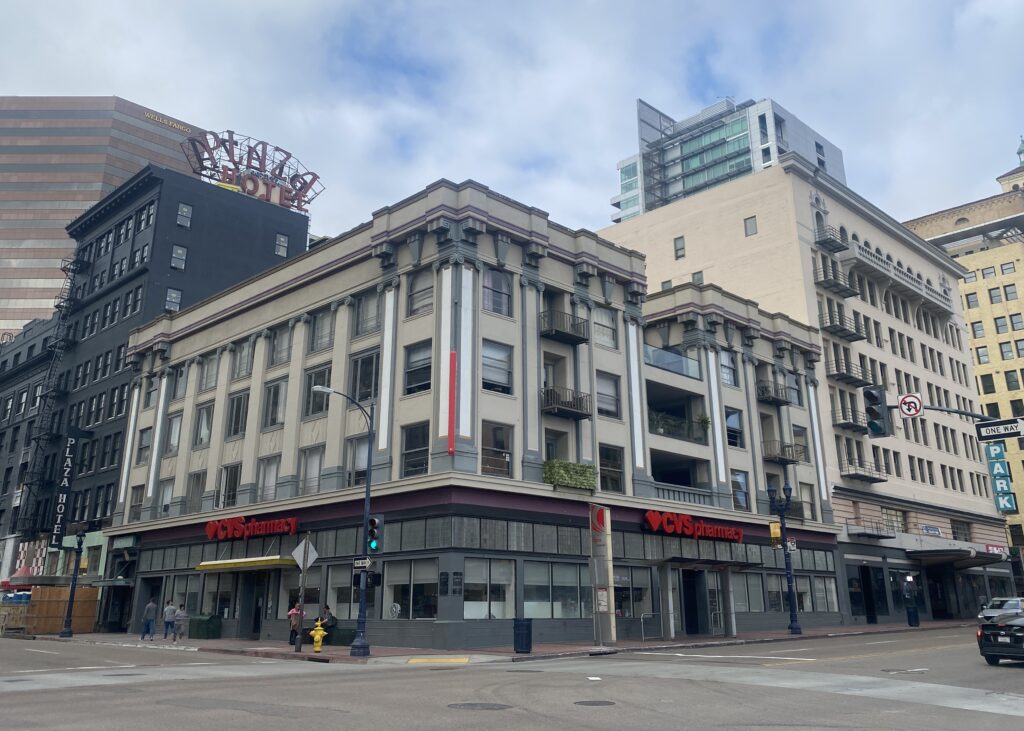No products in the cart.
Landmarks
Rue the Blue!
Owl Drugstore Building
Northeast Corner of 4th and Broadway
Architects: Quayle Brothers & Charles Cressey
Architectural Style: Neo-Classical
Many travelers arrive at their destination only to discover that they have forgotten to pack one of their essentials. A toothbrush? A comb? Talcum powder? Perhaps U.S. Grant, Jr. considered this common dilemma when he set about building the structure that was to become the Owl Drugstore, located across the street from his signature project, the U.S. Grant Hotel.
The imposing, 4-story building was designed by the Quayle Brothers and their new partner, Charles Cressey, but actually constructed by an Oakland firm – Oliver Duval and Company. When the edifice was completed in 1913, it featured an open courtyard facing Broadway, which was later filled in.
The rectangular structure, modeled after the U.S. Grant Hotel, is marked with strong vertical features by alternating rows of square windows and Ionic pilasters covering three floors. A deep, plain frieze across the top imparts a strong horizontal balance. The exterior, which was finished with cement and artificial stone, features decorative columns extending from the second story to just below the roof cornice. The roof is flat with an unadorned parapet. The Fourth Avenue side featured multiple rows of prismatic tiles to add additional light towards the recesses of the structure. This is one of the few characteristics of the original store fronts that have remained.
The interior first floor featured four businesses, while the upstairs contained offices, all including a lavatory and a clothes closet.
When opened, the Owl Drug Store occupied the corner store, while other businesses occupied the three other ground floor spaces. These enterprises included Hart, Schaffner & Marx Clothes, Farley Outfitting and Brooks Clothing Company. The longest lasting was the Owl Drugstore which remained until 1960, before it changed hands.
Owl Drug Company was a chain of apothecary retail stores that sold drugs and patent medicines at a reduced cost. Additionally, they also sold candy, soda, Kodak film, stationary, cosmetics, perfumes and other toiletries. The first store opened in June of 1892 in San Francisco, and billed themselves as the “Drug Palace of the Pacific Coast.” The five partners/directors were Derwent Kirkland, Henry Trowbridge, P.J. Tormey, Richard Miller and Frederick Stratton. Before opening the Owl, Kirkland and Trowbridge had been leading pharmacists in Oakland, California, and also owned a hardware store.
Upon opening, the group was met with a major boycott by the San Francisco Retail Druggists Association, because the Owl partners refused to join the association and because they set their prices below the established fee schedule of the association. The Owl Drug Store outlasted the boycott, and opened their second store in 1894 in Los Angeles. By 1918, there were 26 retail stores in California, Oregon and Washington, and by 1937 there were more than 125 stores in the chain. By 1909, Mr. Miller was in control of most of the stock in the company due to friction between himself and Mr. Trowbridge. Miller simply bought everyone out. He remained in control until his death in 1934.
Not only was the Owl Drug Company known for their low prices, they also excelled in variety. Their counter displays featured Varna Rouge, KCL toothpaste, Beech Nut Gum, Jonteel Powder (face powder), Vernice Preparations (laxatives), Owl Cold Cream, Mary Garden beauty products, Red Feather beauty products, Bay Rum, Owl Epsom Salts, Lord Baltimore Linen (playing cards with linen finish), Mirimbi Lily products (imported cosmetics) and talcum powder.
In the notions department, the Owl featured playing cards, razor blades, powders, wallets, fountain pens, toothbrushes, lipstick, pocket combs and manicure aids.
Their plate glass window contained artful displays featuring Kodak film and albums, Djer Kiss Talcum Powder, Keystone Shaving Cream, Creme Elcaya fragrance, Ezonall Shaving Cream, Bromo-Seltzer, Chlorox Tooth Paste, Clemente Soaps, various Owl drugs and a Star Vibrator for head-aches.
The druggist (or apothecary) also had a private lab where medicines not on the shelf could be compounded and botanicals, herbs and minerals could be pounded and processed for use. The late 19th and early 20th centuries were a time of extensive experimentation with new drugs that had been isolated as to their active ingredient. Of course, most of the experimentation was done on animals. Popular drugs utilized were morphine, cocaine, opium, arsenic and mercury. The latter two were widely used to cure syphilis. On the apothecary’s shelf also were camphor, chamomile, willow bark, chlorine. carbolic acid, lime, charcoal, sulphur, caffeine, digitalis, ginger and parsley. There were also the standards – leeches and spermaceti used for any number of things.
If you preferred to mix your own poison or act as your own exterminator, clients could make their purchase from the separate poison shelf. Most of the poisons were distinguished by the signature handblown, cobalt blue glass bottles. The larger ones were triangular, and featured a winged owl perched on a mortar and pestle on one side, “poison” embossed on an-other, and “The Owl Drug Company “on the third. They are now quite collectable with prices ranging upwards from $479. If that is a bit too steep for your budget, one may purchase an antique Owl thermometer for $60, a bottle of aspirins for $199.99, a bar of Owl soap for $45 or a “shot” glass to bolt down your medicine for $150. Something for everyone!
After Mr. Miller died in 1934, the company went into bankruptcy, and was purchased by the Rexall Drug Company. The Owl continued to operate as a subsidiary until 1970, when the name was changed to Owl Rexall Drug Company.
Throughout the 1970s the San Diego storefront housed a variety of businesses featuring everything from fast food to jewelry to shoeshines.
The entire first floor and the basement now house CVS Pharmacy (another drug chain!), while the upper stories are occupied by Viridian Lofts.
Sandee is the Historian/Lead Tour Guide for the Gaslamp Quarter Historical Foundation. She can be reached at [email protected].

